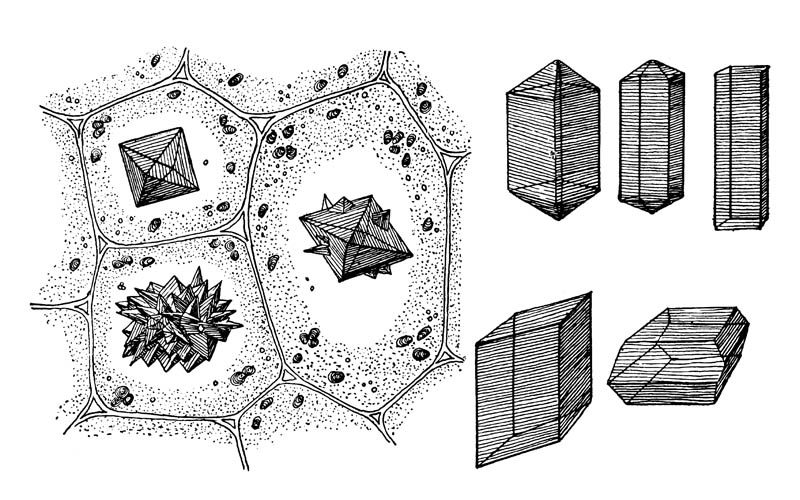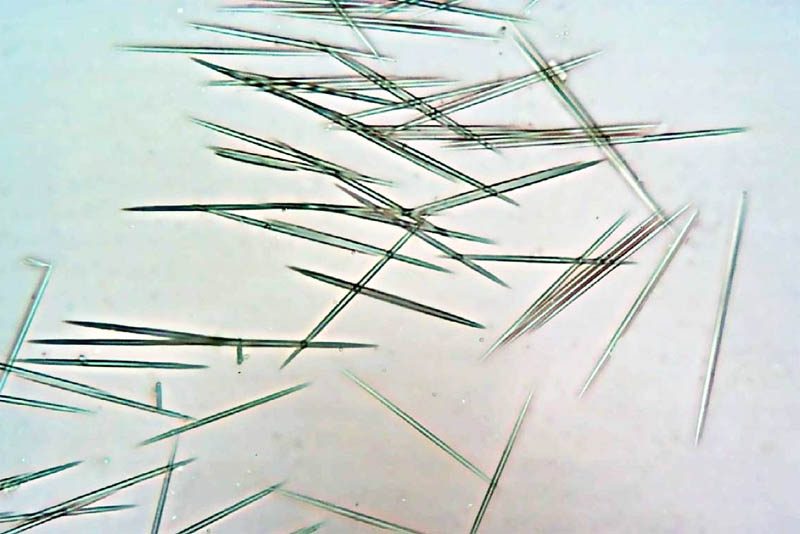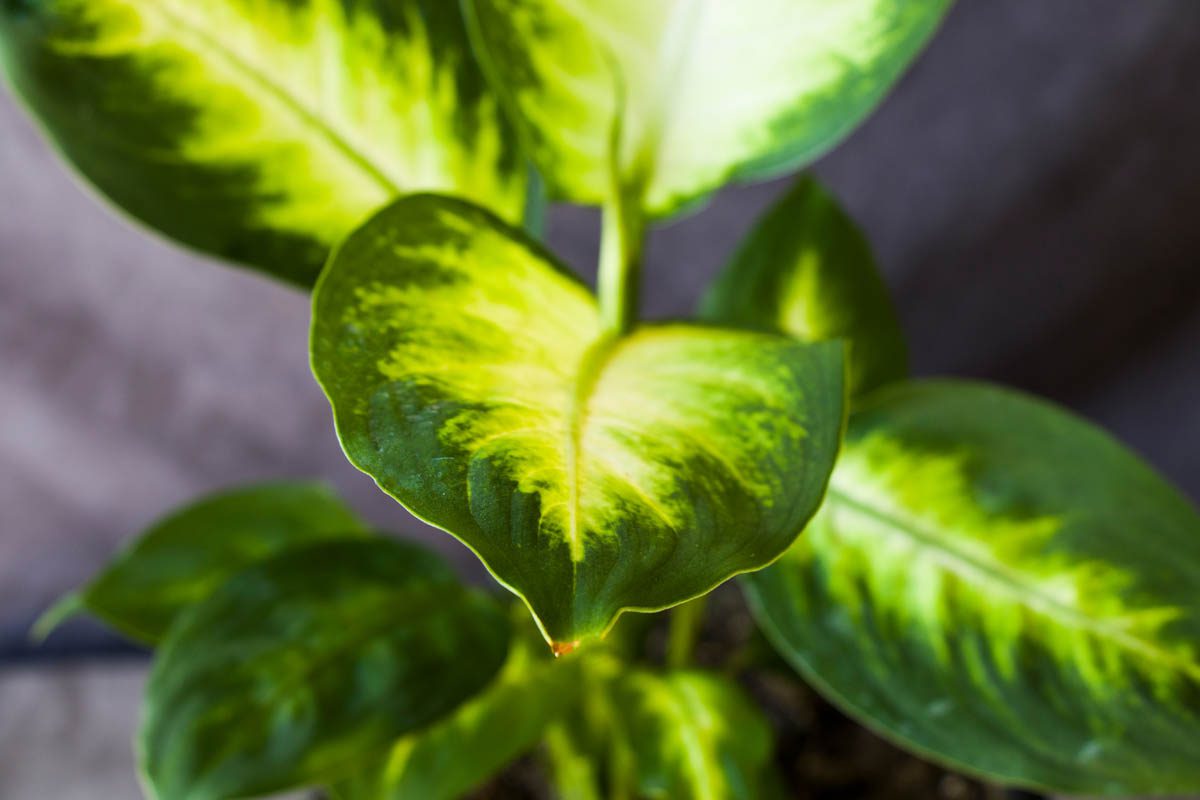What are insoluble calcium oxalate crystals?
The discovery of calcium oxalate crystals was made in the mid-17th century by Marcello Malpighi (1628-1694), an Italian physician, biologist, and anatomist. Dr Malpighi used the newly-invented microscope to examine the internal structure of plants and described them his work ‘Anatome Plantarum‘, which was published in 1675. In his book, he refers to calcium oxalate crystals as ‘sarmenta‘, which he observed in the stems, leaves and roots of a number of plant species.
Calcium oxalate crystals are found in five morphologies:
- Raphides (needle-shaped crystals)
- Druses (spherical aggregate of individual crystals)
- Styloids (elongated crystals with ridged or pointed ends)
- Prismatic (four or more sides similar in length and width)
- Crystal sands (minute crystals in a single cell).
The focus of this article is raphides, which pose the greatest risk to humans and animals due to their shape which allows them to penetrate the tissues of the oropharynx and gastrointestinal tract. They can vary in size from micrometres to several millimetres and may be straight, clustered in groups, curved or spiral shaped or branched with multiple needle-like projections.

Raphides formed are stored in specialised cells called idioblasts. When the plant is damaged, the idioblasts rupture and release the raphides into the surrounding tissue. The reaction to insoluble calcium oxalate-containing plants is classed as mechanical irritant contact dermatitis, due to the physical injury it causes to the oropharynx.
Related: What are grayanotoxins?
What is the function of raphides?
The function of raphides varies according to the plant species and the type of crystals present.
- The primary function of insoluble calcium oxalate crystals is to protect the plant against herbivory. When an insect or animal chews on a CaOx-containing plant, the needle-sharp crystals penetrate the mouth and digestive tract causing intense pain and burning. Some crystals also have also barbs and grooves that anchor insoluble calcium oxalate crystals to the wound, allowing proteolytic enzymes to penetrate the tissues, intensifying pain and burning.
- Regulation of free calcium in the tissues.
- In some species of plants, insoluble calcium oxalate crystals play a role in seed germination by providing a source of calcium for the developing embryo. Calcium is essential for many physiological processes in plants, such as cell division and growth. In some plants, raphides are concentrated in the seed coat or endosperm, which may help protect the seed from predation or environmental stresses.
How are raphides formed?
Raphide formation begins in the idioblasts when calcium and oxalate ions, produced by the plant as waste products of metabolism², bind together to form calcium oxalate crystals which then grow and elongate. Once formed, raphides can be stored for long periods of time within the idioblasts. In some plants, raphides are located in specific tissues or organs, while in others, they are distributed throughout the plant.
Idioblasts are lined with a membrane made up of cellulose or other polysaccharides which may help to protect the surrounding cells from the sharp edges of the raphides.
Not all plants that produce raphides are toxic. Some plants only contain a small number of raphides and are generally safe, these include common herbs such as basil, dill, sage, lavender, bay leaves and tarragon. However, plants that contain large amounts of raphides such as taro and Dieffenbachia can cause intense pain and burning when consumed.
Protease enzymes
Ingestion of raphide-containing plants can be intensified by the addition of protease enzymes. These enzymes are involved in a number of biological processes including protein degradation, seed germination and defence against pathogens. When the plant is damaged, raphides penetrate the tissues, which allows entry of protease enzymes. These enzymes break down proteins in the mouth and digestive tract, which cause severe irritation in the mouth, throat and digestive tract.
Dieffenbachia (dumb cane), is a popular house plant with a dark history. This plant was used by Caribbean sugar plantation farmers to punish Jamaican slaves. Slave owners would force enslaved individuals to chew on or ingest the plant, causing intense pain, blisters and an inability to speak. This is where the name dumb cane originated, and why the scientific name Dieffenbachia should be used in its place. Nazi Heinrich Himmler proposed the use of Dieffenbachia seguine to mass sterilise prisoners, however, he was unable to obtain the plants from Latin America. The use of Dieffenbachia as a form of punishment or torture is illegal and considered a violation of human rights.
What happens if a plant that contains raphides is consumed?
The severity of signs depends on the concentration and type of oxalate crystals present in the plant tissue. When an insect or animal chews a plant containing raphides, the needle-sharp crystals are released from the cells and penetrate the delicate tissues of the lips, mouth and throat causing pain, burning, swelling, and difficulty swallowing.

Symptoms of insoluble calcium oxalate exposure include pain, burning, swelling, drooling, and loss of appetite.
Plants that contain raphides
Common plants that contain insoluble calcium oxalate crystals, this list is by no means extensive, and it is always recommended you research the toxic properties of any plant you bring into the home.
- Monstera species (Swiss cheese plant, Monstera adansonii etc.)
- Aglaonema (Chinese evergreen)
- Anthurium species (Flamingo plant)
- Dieffenbachia species
- Philodendron species
- Rhaphidophora species (Mini monstera)
- Spathiphyllum (Peace lily)
- Caladium species
- Zantedeschia species
- Syngonium species
- Epipremnum (Devil’s ivy)
- Alocasia species (Elephants ears)
- Caladium species
- Brassaia (Umbrella Tree)
- Parthenocissus quinquefolia (Virginia creeper)
- Rheum rhabarbarum (Rhubarb)
Crystal sand is a term used to describe types of crystals, which includes raphides, in plant tissues. Large numbers of crystal idioblasts in tissue can cause the plant to take on a sandy texture.
First aid
Because pain is almost immediate, most children and animals will not eat a significant amount of plant material. However, in some cases, swelling can occur in the throat, resulting in airway obstruction which requires immediate medical care. There is a single case of a dog fatality after consuming Dieffenbachia. Large ingestions of plant matter that contains CaOx can lead to gastrointestinal disturbances, but this is rare due to the immediate pain experienced upon exposure.
If a child or pet consumes a plant containing insoluble calcium oxalate crystals, carefully remove any remaining plant matter from the mouth and offer something cool, such as milk or yoghurt which may help to bind to the oxalate crystals. Do not induce vomiting as this can cause additional irritation to the mouth and throat, and increase the risk of aspiration.
Is it safe to keep plants that contain raphides?
There is always a risk that if a child or animal ingests any part of a plant that contains insoluble calcium oxalate crystals they will experience pain. This is usually enough to stop further ingestion and is generally considered mild and self-limiting. Some children and dogs will consume anything and therefore should not have access to insoluble calcium oxalate-containing plants.
Potential applications
While raphides are known for their role in plant defences, scientists are looking into potential uses within the pharmaceutical industry.
- Drug delivery: The small size or raphides and ability to penetrate cell membranes have the potential to be used to deliver drugs to cancer cells. One study found that raphides derived from Dieffenbachia seguine effectively delivered the chemotherapy drug doxorubicin to breast cancer cells in vitro. The researchers found that the raphides increased the cellular uptake of the drug and enhanced its cytotoxicity, which is the ability to kill cancer cells.³
- Pesticides: A study published in the Journal of Economic Entomology in 2015 found that raphides extracted from the leaves of taro plants (Colocasia esculenta) had insecticidal activity against the diamondback moth (Plutella xylostella), a major pest of cabbage and other cruciferous vegetables. Researchers found raphides significantly reduced both the number of diamondback moth larvae as well as pupae.⁴
- Nanotechnology: Their small size and unique crystal structure have the potential to be a source of nanomaterials for use in the electronic industry.
References
- Gandhi, M., & Naik, S. N. (2015). Oxalate-rich foods. Critical Reviews in Food Science and Nutrition, 55(3), 358-367.
- Mauseth, J. D. (2016). Botany: An Introduction to Plant Biology. Jones & Bartlett Publishers.
- Kumar, A., Singh, K. P., Chandra, R., & Jain, S. K. (2013). Calcium oxalate crystals as a novel vehicle for delivery of anticancer drug doxorubicin: In vitro and in vivo studies. PLOS ONE, 8(4), e60381.
- Ravi, S., Uma, S., & Suryanarayanan, T. S. (2015). Calcium oxalate raphides from taro (Colocasia esculenta) are toxic to diamondback moth larvae. Journal of Economic Entomology, 108(6), 2596-2605.
Julia is a writer and landscape consultant from Wollongong with a love of horticulture. She had been an avid gardener for over 30 years, collects rare variegated plants and is a home orchardist. Julia is passionate about learning and sharing her knowledge of plant propagation and plant toxicology. Whether it’s giving advice on landscape projects or sharing tips on growing, Julia enjoys helping people make their gardens flourish.




